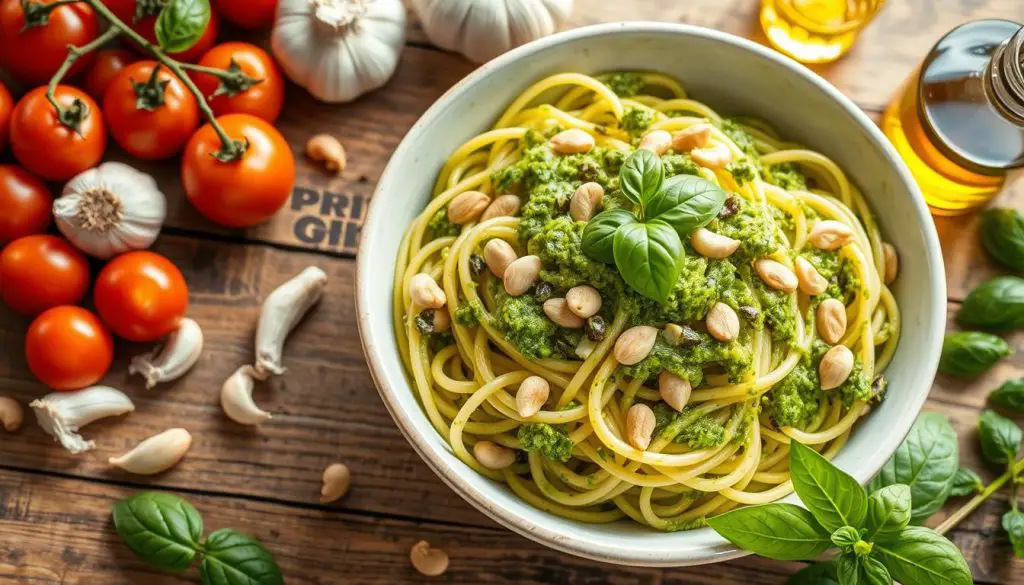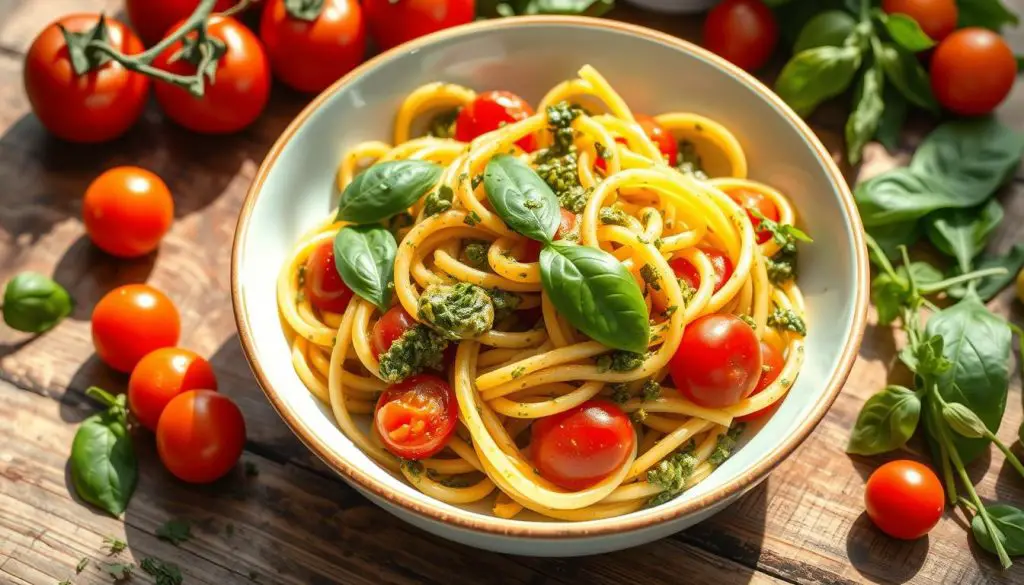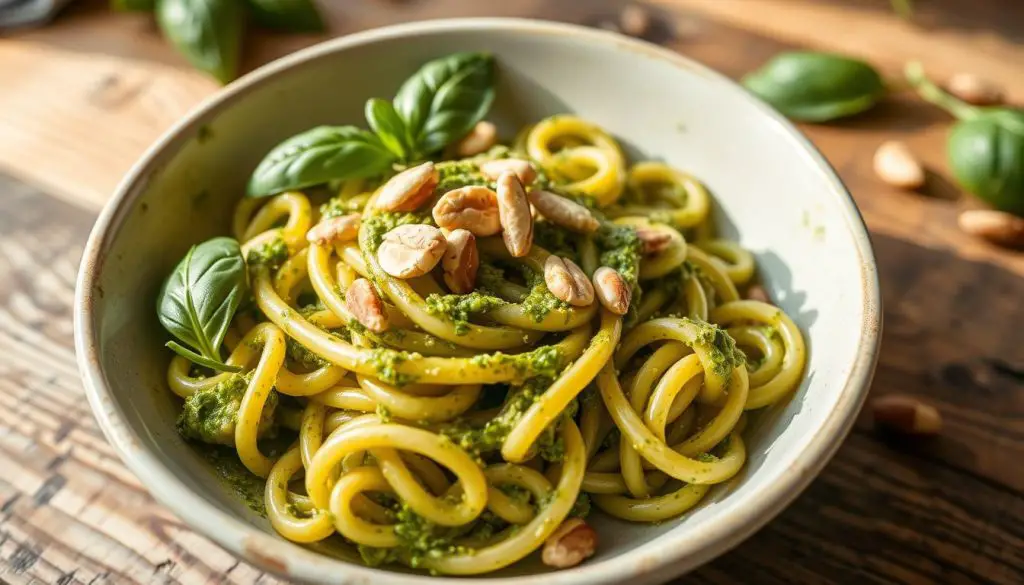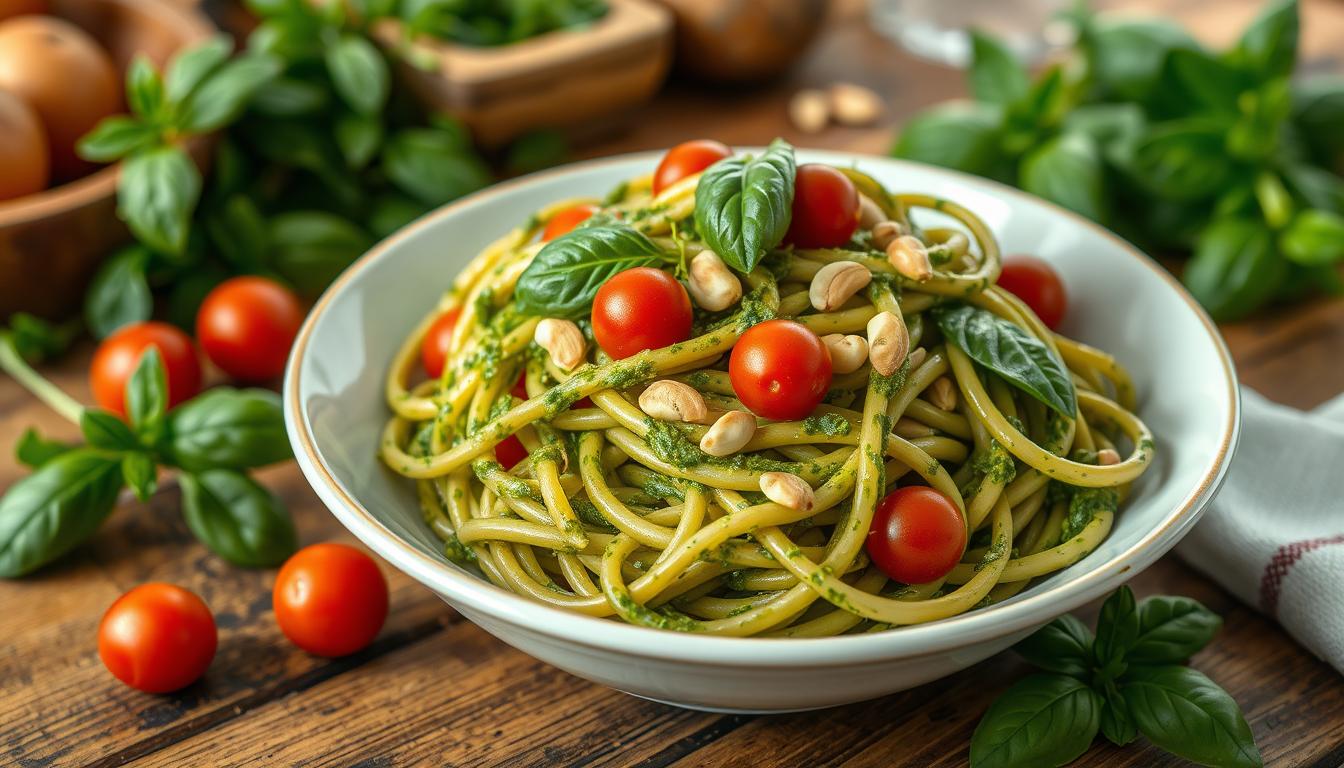Could a simple pasta dish help manage your fibromyalgia symptoms? The answer might be in the pasta type. Switching to gluten-free pasta can make a meal that may reduce inflammation and ease pain. Studies show that a gluten-free diet can significantly improve symptoms, making it a game-changer for those with this condition.
The recipe’s benefits don’t end there. Adding a vibrant pesto sauce, rich in anti-inflammatory ingredients like basil and olive oil, supports your body’s healing. A recent study found that pine nuts can help lower waist circumference, blood pressure, and increase HDL (good) cholesterol. These are all key for managing fibromyalgia.
Gluten-Free Pasta: A Delicious Solution for Fibromyalgia
Many people with fibromyalgia find relief in a gluten-free diet. Gluten, found in wheat, rye, and barley, can cause inflammation. This makes fibromyalgia symptoms worse.
Eliminating Gluten to Reduce Inflammatory Symptoms
Removing gluten from the diet can help. It can lessen muscle aches, fatigue, and headaches. This change can reduce inflammation and offer relief.
Gluten Intolerance and Its Connection to Various Health Issues
Gluten intolerance is also tied to arthritis and asthma. A gluten-free diet can improve overall health. It helps manage inflammation and improve life quality.
At Lisa’s 1973, we offer tasty, healthy options for those with fibromyalgia symptoms. Our gluten-free pasta with basil pesto is a delicious way to manage symptoms.
The Benefits of a Gluten-Free, Fiber-Rich Diet
Switching to a gluten-free diet and eating fiber-rich meals can greatly help those with fibromyalgia. It not only cuts down on inflammation but also brings many health benefits.
Many studies show that a fiber-rich diet is good for fibromyalgia. A 2019 review in the Annals of Medicine found that diet helped in five out of seven studies on fibromyalgia. A 2016 study in the International Journal for Vitamin and Nutrition Research also found that antioxidant-rich diets improved life quality and reduced tender points in fibromyalgia patients.
Eating gluten-free, fiber-rich foods has many benefits. For example, a study in the Journal of the Academy of Nutrition and Dietetics found that fruits, vegetables, and fish improved mental health in women with fibromyalgia. On the other hand, processed meats and sweet drinks were linked to depression in fibromyalgia patients, as a study in Clinical Rheumatology showed.
When it comes to gluten-free pasta, chickpea pasta is a top choice. It has more protein, fiber, and iron than traditional pasta. Legumes like chickpeas have also been linked to lower heart disease risk and better blood sugar control.
Adding fiber-rich, gluten-free ingredients to your diet can help your body fight inflammation. This can reduce chronic pain and other fibromyalgia symptoms. Adopting this diet can lead to a better life and overall health.
Anti-Inflammatory Diets: Easing Chronic Pain Naturally
For those with fibromyalgia, an anti-inflammatory diet can be a game-changer. It helps manage symptoms and reduce pain. Focus on whole, plant-based foods that are full of antioxidants and anti-inflammatory compounds. This helps your body fight inflammation that worsens fibromyalgia symptoms.
Adding anti-inflammatory herbs and spices to your meals can also help. They offer natural pain relief.
Plant-Based Protein Sources for Fibromyalgia Management
Plant-based proteins are also good for fibromyalgia. Foods like lentils, beans, and quinoa are full of nutrients. They don’t have the inflammatory effects that some animal proteins do. Adding these to your diet supports your health and meets the needs of those with fibromyalgia.
Here are some tips to enhance your anti-inflammatory diet:
- Prioritize whole, minimally processed foods
- Increase your intake of fruits, vegetables, and whole grains
- Experiment with new anti-inflammatory recipes and cooking methods
- Stay hydrated and limit your intake of added sugars and refined carbohydrates
- Consult with a registered dietitian to develop a personalized plan
By choosing the right foods and adding anti-inflammatory foods, you can manage fibromyalgia pain. Remember, everyone’s needs are different. Listen to your body as you try an anti-inflammatory diet.
Gluten-free pasta with pesto for fibromyalgia
If you have fibromyalgia, adding gluten-free pasta to your meals can be tasty and healthy. Mix it with a tasty pesto sauce. This combo is full of fiber and can help ease your chronic pain.
When picking gluten-free pasta, choose types made from corn, quinoa, or lentils. These options mimic regular pasta’s feel but don’t cause fibromyalgia symptoms. The pesto sauce, with its basil, olive oil, nuts, and garlic, adds flavor and nutrients for better health.

- 2 cups fresh basil leaves
- 1/2 cup pine nuts or walnuts
- 3 cloves of garlic
- 1/4 cup extra-virgin olive oil
- Juice of 1 lemon
- Salt and pepper to taste
Blend the ingredients in a food processor until smooth. Then, toss the pesto with your gluten-free pasta. Enjoy a meal that’s both tasty and helps with fibromyalgia symptoms.
Nutrient-Dense Recipes for Fibromyalgia Relief
Making nutrient-dense recipes can really help those with fibromyalgia. Using nutrient-rich ingredients like leafy greens, nuts, seeds, and fruits and veggies high in antioxidants can make meals tasty and healthy. These foods give your body the vitamins, minerals, and anti-inflammatory compounds it needs to fight chronic pain and improve overall health.
Incorporating Nutrient-Rich Ingredients into Your Diet
To find fibromyalgia relief, it’s key to add nutrient-dense recipes to your daily meals. Here are some tips to help you:
- Try to get at least 6 grams of fiber per serving in dishes like Red Lentil Soup with Saffron and Vegetable Weight-Loss Soup.
- Choose soups rich in nutrients, such as vegetables, healthy fats, legumes, whole grains, herbs, and spices.
- Focus on anti-inflammatory foods like salmon, olive oil, and leafy greens to fight chronic inflammation.
- Look into vegan options like Vegan Minestrone Soup to meet different dietary needs.
- Use slow-cooker recipes like Lentil Soup and Vegetarian Chili for easy meal prep and less cooking time.
- Make sure your soups, like Minestrone, have lots of vegetables to get plenty of veggies in one dish.
By adding these nutrient-rich ingredients to your meals, you can make tasty and healthy dishes. These meals will help your body heal naturally and ease fibromyalgia symptoms.
The Versatility of Pesto Sauce
Pesto sauce can make your meals more flavorful and nutritious. It’s not just basil pesto; you can try many other pesto types. These variations can give your dishes a new twist while keeping the health benefits.
Exploring Different Pesto Variations
While basil pesto is loved by many, there are endless pesto options. You can mix in arugula, spinach, kale, or herbs like mint or cilantro. These pestos add flavor and nutrients to your meals.
Arugula pesto is packed with antioxidants and may fight inflammation. Spinach pesto is full of fiber and vitamins. Kale pesto is rich in vitamins A, C, and K, and minerals like calcium and iron. Trying these pestos can make your meals tastier and healthier.
| Pesto Variation | Key Nutrients | Potential Benefits |
|---|---|---|
| Arugula Pesto | Vitamin K, folate, calcium, magnesium | May help reduce inflammation and support bone health |
| Spinach Pesto | Vitamin A, vitamin C, vitamin K, fiber, iron | Supports immune function and gut health |
| Kale Pesto | Vitamin A, vitamin C, vitamin K, calcium, iron | Promotes healthy vision and bone density |
Adding these pesto variations to your meals can bring new flavors and health benefits. Try different pestos to find what you like best.
Dietary Management Strategies for Fibromyalgia
Effective dietary management is key for those with fibromyalgia. A diet rich in anti-inflammatory, nutrient-dense foods can help ease symptoms. This includes avoiding gluten and eating more fiber-rich, plant-based meals.
Identifying and avoiding foods that worsen symptoms is important. For many, gluten and FODMAPs can trigger flare-ups. A gluten-free, fiber-rich diet can help reduce inflammation and manage symptoms better.
Adding anti-inflammatory foods to your meals is also beneficial. Foods high in omega-3 fatty acids, like fatty fish, nuts, and seeds, can help with chronic pain. Antioxidant-rich fruits and vegetables also support health and well-being.
- Try a Mediterranean-style diet with lots of plant-based foods, healthy fats, and less processed items.
- Adopting a vegetarian or vegan diet can help by reducing inflammation and improving gut health.
- Make sure you get all the necessary vitamins, minerals, and nutrients with a personalized diet plan from a healthcare professional.
Finding the right balance in your diet is the key to managing fibromyalgia. By making gradual, sustainable changes, you can manage your symptoms and improve your life quality.
Gluten Sensitivity and Its Impact on Daily Life
Living with fibromyalgia is tough enough. But for those with gluten sensitivity, following a gluten-free lifestyle makes things even harder. Gluten, found in grains like wheat, barley, and rye, can cause problems for people with celiac disease, non-celiac gluten sensitivity (NCGS), or wheat allergies.
Identifying and Avoiding Hidden Sources of Gluten
Managing gluten sensitivity means being careful about where gluten hides. It’s in unexpected foods like processed items, sauces, condiments, and some meds. It’s vital to learn how to read labels well and know all the ways gluten can hide for those with fibromyalgia and gluten intolerance.
- Gluten is in grains like wheat, barley, rye, and triticale.
- Condiments like soy sauce, many salad dressings, marinades, and spice blends may contain gluten.
- Breads, crackers, wraps, cakes, pastries, and pretzels often contain gluten.
- Wheat-based pastas, snack foods, and certain beverages like beer might also contain gluten.
By taking charge and learning, people with fibromyalgia can handle their gluten sensitivity better. Getting help from healthcare pros or dietitians can also help a lot. They can guide you on living gluten-free and making sure you get all the nutrients you need.

Starting a gluten-free diet might seem scary. But with the right help and support, people with fibromyalgia can find fun ways to eat well. They can enjoy meals that are good for their health without feeling left out.
Basil Pesto Sauce: A Flavorful and Nutritious Addition
Take your basil pesto to the next level by adding it to your fibromyalgia-friendly meals. This vibrant sauce is made with fresh basil, olive oil, pine nuts, garlic, and Parmesan (or a dairy-free option). It’s a flavor-packed powerhouse that can make any dish better.
Pesto is great for a balanced diet, thanks to its healthy fats, antioxidants, and plant-based proteins. The fresh basil in it has anti-inflammatory benefits. The olive oil and nuts add good fats like monounsaturated and omega-3 fatty acids.
Try different pesto variations to spice up your meals. Mix in arugula, chickweed, or peppermint for a twist on classic basil pesto. You can also make nut-free pesto with sunflower or pumpkin seeds for a tasty, fibromyalgia-friendly choice.
Use pesto with gluten-free pasta, roasted veggies, or as a sandwich spread for a flavor boost. Its versatility makes it a must-have in any kitchen, perfect for those looking for nutrient-dense and fibromyalgia-friendly meals.
Whole Grain Alternatives for Gluten-Free Pasta
If you have fibromyalgia, finding tasty and healthy gluten-free pasta is key. Traditional gluten-free pasta is good, but whole grain options offer more benefits. They help manage your condition better.
Exploring Different Types of Gluten-Free Pasta
Quinoa, brown rice, and lentil-based pastas are great whole grain gluten-free choices. They meet your dietary needs and add fiber, protein, and complex carbs. These are good for people with fibromyalgia.
- Quinoa pasta is packed with nutrients, including plant-based protein and vitamins.
- Brown rice pasta is filling, with complex carbs that help control blood sugar and give lasting energy.
- Lentil-based pastas are high in fiber and protein, helping with digestion and muscle health.
Trying these whole grain gluten-free pastas can help you find what you like. You’ll enjoy meals that are good for your fibromyalgia.

Using whole grain alternatives is a smart way to manage fibromyalgia symptoms. It supports your overall health and well-being.
Meal Prepping and Batch Cooking for Fibromyalgia
Living with fibromyalgia can make everyday tasks hard. Meal prepping and batch cooking can change the game. They let you have healthy meals ready without the stress and effort of cooking every day.
Set aside time on weekends or when you’re feeling better to cook big batches. Try making gluten-free pasta with pesto or other anti-inflammatory dishes. This way, you’ll have healthy meals all week. It saves time, energy, and helps you stick to a fibromyalgia management diet.
- Prepare larger batches of recipes like gluten-free pasta with pesto, minestrone soup, or grilled salmon with chermoula chickpeas.
- Store the pre-cooked meals in individual portions, making it easy to reheat and enjoy when you need a quick, nourishing meal.
- Incorporate a variety of vegetables, lean proteins, and complex carbohydrates into your meal prep to ensure optimal nutrient intake.
- Experiment with flavorful, anti-inflammatory ingredients like herbs, spices, and healthy fats to make your meals both delicious and beneficial for your condition.
Adopting meal prepping and batch cooking can help you manage fibromyalgia better. A little time upfront leads to a healthier, more consistent diet all week.
Sharing Meals with Family and Friends
Sharing meals with loved ones is a special part of life, even for those with fibromyalgia. But, dealing with dietary restrictions in social situations can be tough. By talking about your needs, teaching others about your condition, and planning meals ahead, you can enjoy these moments without hurting your health.
Navigating Social Situations with Dietary Restrictions
At social events, it’s important to talk about your dietary needs. You can ask about the menu or if the host can make something for you. Many people are happy to help, if you explain your situation kindly.
When you bring a dish, choose something gluten-free and full of fiber. This way, you have a safe choice and everyone gets to enjoy it. Being prepared helps you relax and enjoy time with your friends and family.
Your health is the most important thing. With a bit of creativity and talking openly, you can make meals fun for everyone.

| Tip | Description |
|---|---|
| Communicate your needs | Don’t be afraid to ask about the menu or inquire if the host can accommodate your dietary restrictions. |
| Bring a dish to share | Opt for a gluten-free, fiber-rich recipe that aligns with your fibromyalgia management plan. |
| Focus on connecting | With a little creativity and open communication, you can find ways to make mealtimes inclusive and enjoyable for everyone. |
By using these tips, you can handle social situations with dietary restrictions and fibromyalgia management better. This way, you can join in and make lasting memories with your family and friends.
Traditional Italian Pesto: Respecting Cultural Traditions
Exploring pesto variations for fibromyalgia diets is important. We must respect the cultural traditions of traditional Italian pesto. This sauce comes from Liguria, Italy, and includes fresh basil, pine nuts, garlic, Parmesan cheese, and olive oil.
Using high-quality, organic ingredients is key to honoring traditional pesto. Choose fragrant basil and premium olive oil. Add Parmesan or a dairy-free alternative to keep the dish true to its roots.
Also, pesto’s versatility can lead to exciting discoveries. Try different nuts, greens, or herbs to create unique flavors. This way, you can make the dish fit your dietary needs while staying true to the Italian recipe.
By honoring the cultural traditions of Italian pesto, you can make your meals special. This shows respect for the rich history and diversity of global cuisine.
Personalizing Recipes for Individual Preferences
Managing fibromyalgia through diet is not a one-size-fits-all solution. Everyone has different tastes, sensitivities, and needs. By trying out various ingredients and cooking styles, you can find the perfect gluten-free pasta and pesto for you. These meals should not only taste great but also help manage your fibromyalgia-friendly meals effectively.
Listening to your body’s food preferences can greatly impact managing fibromyalgia. You might enjoy a bold pesto or a creamy one. Maybe you need more protein or lots of veggies. The important thing is to find what works best for you.
Personalizing your recipes can make meals more enjoyable and nourishing. Trying new flavors and cooking methods can make eating more fun. It also helps you find the foods that best help your fibromyalgia. Enjoy the process of finding your own personalized recipes and using your individual preferences to manage your condition.
Source Links
- https://www.realfoodforlife.com/green-beans-pesto-pasta/
- https://justglowingwithhealth.com/zucchini-pasta-with-sun-dried-tomato-kale-pesto/
- https://www.realfoodforlife.com/vegan-pesto/
- https://nourishingmeals.com/
- https://medium.com/authority-magazine/how-chef-lisa-roberts-hurd-of-lisas-1973-is-helping-to-promote-healthy-eating-7a6199bd87ed
- https://www.verywellhealth.com/fibromyalgia-diet-good-and-bad-foods-4144693
- https://www.healthline.com/nutrition/chickpea-pasta
- https://www.healthline.com/health/rheumatoid-arthritis/seven-day-meal-plan
- https://www.eatingwell.com/article/291150/fibromyalgia-diet-foods-you-should-eat-and-foods-you-should-avoid/
- https://sharethepasta.org/pasta-spotlights/a-registered-dietitian-that-loves-pasta-and-is-gluten-free/
- https://www.eatingwell.com/gallery/7959990/anti-inflammatory-high-fiber-soup-recipes/
- https://fullyfunctional.com/blog/category/all/
- https://www.healthline.com/nutrition/what-to-put-in-pasta
- https://medium.com/authority-magazine/how-chef-lisa-roberts-hurd-is-helping-to-promote-healthy-eating-7381429149c2
- https://www.eatingwell.com/article/7866119/rheumatoid-arthritis-diet-plan/
- https://www.throughthefibrofog.com/cooking-chronic-illness/
- https://www.healthline.com/nutrition/gluten-food-list
- https://www.cooksmarts.com/articles/gluten-free-diet-substitutions-list/
- https://www.throughthefibrofog.com/roasted-red-pepper-sauce-nomato-sauce/
- https://nourishingmeals.com/2016/12/nightshade-free-chicken-taco-recipe
- https://nourishingmeals.com/search?updated-min=2016-01-01T00:00:00-08:00&updated-max=2017-01-01T00:00:00-08:00&max-results=12&search=&page=33
- https://www.assuredscreening.com/@t/edu/search?CHAPTER=simply sugar and gluten free 180 easy and delicious recipes you can make in 20 minutes or less.pdf
- https://nourishingmeals.com/diet/basic-elimination-diet
- https://www.christinebailey.co.uk/wp-content/uploads/2021/03/Lectin-recipes.pdf
- https://www.aol.com/23-easy-weight-loss-meal-193046135.html
- https://www.budgetsavvydiva.com/2014/02/top-25-gluten-free-recipes/
- https://emilyroachwellness.com/category/food/
- http://lifeafterbread.co.uk/category/gluten-free-health/
- https://liveandeatclean.com/my-cancer-journey/
- https://paradigmchange.me/lc/convenience/
- https://moodyindygo.wordpress.com/
- https://thefabulousfrostfarm.com/category/how-to-2/recipe/
